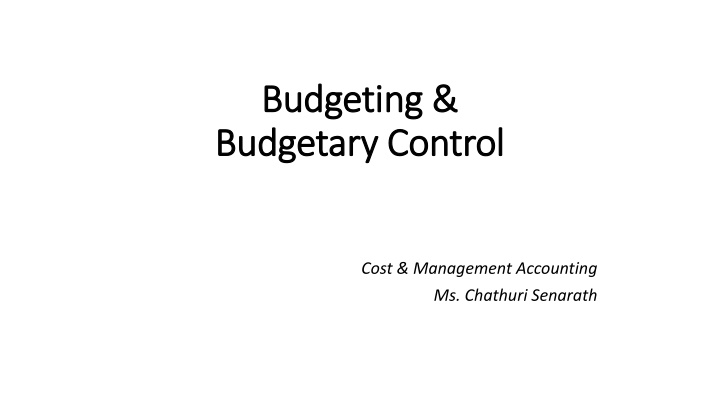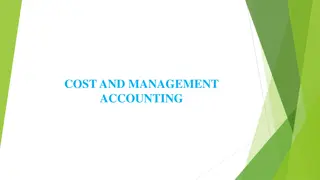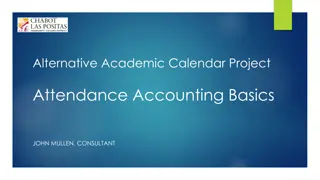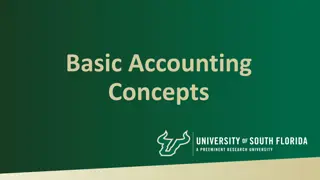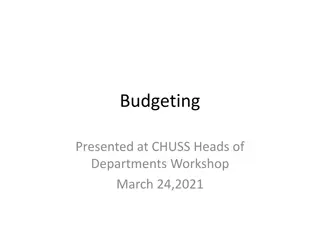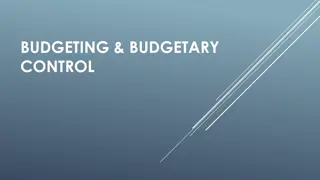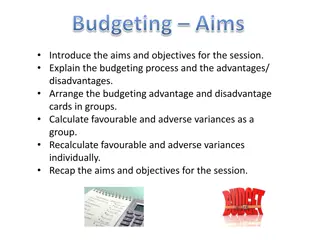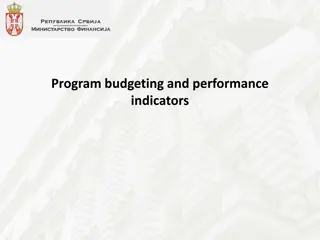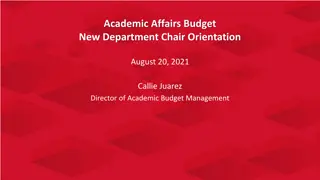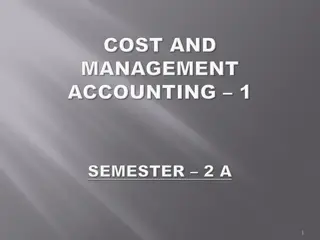Importance of Budgeting and Control in Management Accounting
Budgeting and budgetary control play a crucial role in management accounting by providing a framework for planning, evaluating performance, and controlling resources effectively. Budgets, strategic planning, operational planning, and performance evaluation are key components in this process, leading to better communication, coordination, and motivation within organizations. Budgets act as a yardstick for measuring performance and can influence positive behavior among managers and their teams.
Download Presentation

Please find below an Image/Link to download the presentation.
The content on the website is provided AS IS for your information and personal use only. It may not be sold, licensed, or shared on other websites without obtaining consent from the author.If you encounter any issues during the download, it is possible that the publisher has removed the file from their server.
You are allowed to download the files provided on this website for personal or commercial use, subject to the condition that they are used lawfully. All files are the property of their respective owners.
The content on the website is provided AS IS for your information and personal use only. It may not be sold, licensed, or shared on other websites without obtaining consent from the author.
E N D
Presentation Transcript
Budgeting & Budgeting & Budgetary Control Budgetary Control Cost & Management Accounting Ms. Chathuri Senarath
Budgets, budgeting and budgetary control Budgets, budgeting and budgetary control A budget is an estimate or plan, expressed in quantitative terms, consequences of the acquisition or use of an organization s resources. that outlines the The process of preparation of budgets is called budgeting. No system of planning can be successful without an effective and efficient system of control. Budgeting is closely connected with control. The exercise of control in the organization with the help of budgets is known as budgetary control.
Why budgeting ? Why budgeting ? Planning Control & Performance Evaluation Communication & Coordination Motivation
Planning Planning Planning is the process of making proposals in achieving the stated objectives of the organization. There are mainly three types - Strategic planning (long term & overall planning) - Budgetary planning (short term to medium term planning) - Operational planning (day to day planning)
Type of planning Detail Strategic/corporate/ Long range planning Covers time period of more than one year and involves 'The formulating, evaluating and selecting strategies for the aim of preparing a long-term plan of action to attain objectives. Budgetary/short-term tactical planning Involves preparing detailed plans, which generally organization s functions, activities and departments. Works within the framework set by the strategic plans and converts those strategic plans into action. cover one year, for an Operation Planning Planning on a very short term or day to day basis and is concerned with planning how an organization s resources will be used. Works within the framework set by the budgetary plans and converts the budgetary plans into action.
Control & Performance Evaluation Control & Performance Evaluation A budget is a yardstick against which actual performance is measured and assessed. Control over actual performance is provided by the comparisons of actual results against the budget plan. This leads to management by exception (activities not in control are given more focused and managed)
Motivation Motivation Budget is a useful device in influencing managers & their sub- ordinates behavior. A well planned budget is likely to develop a positive behavior, if it is complemented with a proper rewarding system.
Communication and Coordination Communication and Coordination In budgeting there are two types of Communication and Coordination. Pre-budget: when preparing the budget different functions of the organization needs to communication as well as work together. Post budget: once the budget is prepared the budget itself communicates to the relevant managers of their targets and achievements of those targets normally requires coherent/together working.
Planning Budgetary How? The approaches
Stages in the budgeting process Stages in the budgeting process 1. Communicating the details of the budget policy Budget preparation needs to be done considering the long term plans of the top management. The top management will communicate its policy effects of the long term plan (i.e. Any changes in the sales mix, expansion of certain activities, changes in industry productivity etc) to those who are preparing the budgets. demand, changes in
2. Determining the factor that restricts performance In any organization, there is a factor that limits or restricts the performance for a given period, in most cases this is the sales demand, but can also be production capacity for a manufacturing company. This is known as the principle budget factor and will be unique to different organizations and industries as well. 3. Preparation of the sales budget The volume of sales and sales mix decides the level of a company s operations, when sales demand is the factor that restricts output. For this reason, the sales budget is the most important plan in the annual budgeting process. This budget is also the most difficult to produce, because total sales revenue depends on the actions of the customers. In addition, sales demand may be influenced by the state of the economy or the actions of the competitors
4. Initial preparation of various budgets The budget holders (managers responsible for meeting the budgeted performance) can get involved in the preparation of budgets whereby they will submit the budgets relevant to their department to the top management for approval. Any changes will then be made and reconciled to meet the needs of the company. The budget will be set based on the policy of the company. 5. Negotiation of budgets When the budgets are set at the lower levels and submitted for approval to the top management, it is natural to have disagreements on certain costs and also budget slack will be included. Therefore negotiation will take place to bring the budget to a level agreeable to everyone.
6. Coordination and review of budgets When the budgets are been set, it will be done by an individual manager relevant to his/her own department this disregarding the organizational requirements. Also budgets set by different departments may not be compatible with each other e.g. Factory manager would include the purchase of equipment in his/her budget when there are actually, no funds available in the finance department. Therefore the budgets need to be coordinated properly and revised in order to get the best fir with each other.
7. Final acceptance of budget When all the budges are in harmony with each other, they are summarized into a master budget consisting the budgeted profit and loss, balance sheet and a cash flow statement. After the master budget has been approved, responsibility will be given to the individual departments to carry out their own budgets. 8. Budget review At the end of the particular period, the budgets need to be compared with the actual performance of the department and results should be given to the respective departments. This will act as a motivational tool for the budget holders to appraise themselves and strive to be better. Also the management will have to make changes to the existing budgets whenever the environment changes so that meaningful comparisons can be made with the actual.
Budgetary Planning approaches Budgetary Planning approaches Different organizations approach budgeting differently. Main Approaches (concerned with where budgeting is done) Alternative Approaches (concerned with; where ever it is, how it is done)
Main Approaches Main Approaches Top down approach/impose budget - The top management of the organization is preparing the budgets. Bottom up approach/Participatory budget - budget originates management coordinated at higher levels at to lower be levels of and refined and
In Bottom up approach/Participatory budget In Bottom up approach/Participatory budget In Participatory style of budgeting there are certain specific terminologies used: Budgeting committee- a (coordinates and administrate)the preparations. Budgetary manuals- A set of documents containing information on budgetary preparation (coding used, relevant responsible parties, timelines etc) Budget holders- A term used to describe managers who are responsible for achieving their own budget. Budgetary slack- budget holders preparing their own budgets and making it easy to achieve is known as budgetary slack (padding) committee that oversees budgetary
Alternative Approaches Alternative Approaches Incremental Rolling ZBB ABB PPBS
Incremental Incremental Next year s budget prepared on the current year s budget/Actual. plus an extra amount for estimated growth or inflation next year.
Rolling Rolling When the earliest period has lapsed an equal period is added in order to maintain a budget for a fixed period, and if required existing plans are also amended.
ZBB (Zero Based Budgeting ZBB (Zero Based Budgeting) ) rejects the traditional budgeting view Approach as it is prepared for the first time = zero based all cost elements are justified and prioritized Used mainly with discretionary costs and support activity (marketing, research, training, maintenance)
Steps in ZBB Steps in ZBB A description of each organizational activities in a decision package. The packages are then evaluated and ranked in the order of priority. The resources are allocated accordingly.
ABB (Activity Based Budgeting) ABB (Activity Based Budgeting) Inputs Resources Traditional budgeting Types of items Activities Activity-Based Budgeting (ABB) Outputs (Forecast of products / services ) Cost amounts for each item
PPBS (Programme planning Budgeting System) For non profit making organizations
Getting the figures organized The normal/traditional order Functional budget Cash budget Master budget
Sales Budget Product A / Period 1 Product B / Period 1 Units Sales price Sales value
Production Budget Product A /Period 1 Product B /Period 1 Sales units (sales budget) Less Opening Stock (FG) Add Closing Stock (FG) Production Units
Material Usage Budget Material X /Period 1 Material Y /Period 1 Production units (production budget) Per unit requirement Total requirement Rate per unit of material Total cost
Material Purchase Budget Material X /Period 1 Material Y/Period 1 Production requirement (material usage budget) Less Opening stock (RM) Add Closing stock (RM) Total purchase Rate per unit of material Total cost
Labour Budget Labour S /Period 1 Labour US /Period 1 Production units (production budget) Per unit requirement (hrs) Total requirement (hrs) Rate per hour Total cost
Labour Budget Labour S /Period 1 Labour US /Period 1 Production units (production budget) Per unit requirement (hrs) Total requirement (hrs) Rate per hour Total cost
Production Cost Budget Product A /Period 1 Product B /Period 1 Material usage budget ( ) Labour budget ( ) Variable O/H ( ) Fixed O/H ( ) Total cost
Cash Budget Period 1( ) Period 2 ( ) Cash receipts: Cash payments: Net cash flow (receipts payments) Opening balance Closing balance
Master budget Master budget Summarized budget P&L, Balance sheet, Cash flow statements
Control & Performance Evaluation Keeping things under control through continues comparision Yearly/ Quarterly / Monthly/ Daily One main problem .
Budgetary control But comparisons should be between like with like terms Fixed and Flexed (budget cost allowance) How to Flex ??
Flexible Budgets Flexible Budgets Show revenues and expenses that should have occurred at the actual level of activity. May be prepared for any activity level in the relevant range. Reveal variances due to good cost control or lack of cost control. Improve performance evaluation.
Flexible Budgets Flexible Budgets Central concept: If you can tell me what your activity was for the period, I will tell you what your costs and revenue should have been.
Flexible Budgeting Technique Flexible Budgeting Technique Let s look at organisations that produce the same kind of (i.e. standard) product on a regular basis. The question we ask is what happens to costs if we change / increase the output. Identify fixed and variable cost elements of budget / identify semi- variable costs using the high - low method. Calculate the unit cost of variable elements. Multiply by the new volume level. Fixed costs remain constant.
The High The High - - Low Method Low Method Example: The following is the information on 5 previous periods. 1 2 3 4 5 Units 10,000 13,000 14,250 16,570 21,500 Costs ( ) 36,000 43,500 46,625 52,425 64,750 Hint: (1) There are both variable and fixed costs in the above. (2) The variable cost per unit stays the same.
The High The High - - Low Method Low Method Find increase in costs from lowest to highest. Find increase in output from lowest to highest. Divide the increase in costs by the increase in units of output. This must, by definition, be the variable element. The fixed element is therefore the other element.
Budgetary control Feedback Feed forward
Budgetary control Feedback At the end of the period Actual results are compared with Budget and action taken Feed forward At the beginning of the period Forecasted actual results (Budget) are compared with the Target/Plan (Budget) and action taken beforehand
